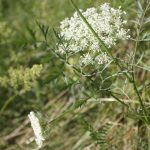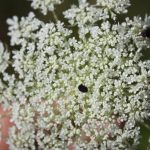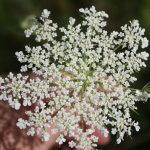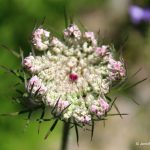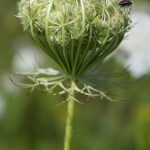Queen Anne’s lace
Prepared by Jennifer L. D’Appollonio, Assistant Scientist, University of Maine, Orono, ME 04469. Updated March 2019.
Scientific name: Daucus carota L.
Common name(s): Queen Anne’s lace, wild carrot, mother die
Link(s): USDA PLANTS Profile, Go Botany
Images: (to see enlargements [PC]: click on image, then right click and choose “view image”)
- early flower, early July
- in flower, late July
- leaf detail
- flowerhead with typical dark red/purple central flower
- atypical flowerhead with no dark central flower
- developing flower umbel with light central flower
- in fruit, mid-August
Description:
– biennial
-leaves are:
- compound
- alternate
- entire
-grows up to 2 feet
– generally flowers June to October in ME
Habitat:
-disturbed areas
-meadows and fields
-partial to full sun
-well drained soils
Agriculture:
-attracts wildlife
-pollinated by flies and beetles
-attracts butterflies
-crowds out native vegetation
Natural History:
-native to Europe
-ancestor of cultivated carrots
-introduced for medical uses
- anti-inflammatory
- soothes digestive tract
- cleansing properties
-the young plant and root is edible
-the sap and foliage has been known to cause skin irritations
Source(s):
Heinrich, B. 1976. Flowering phenologies: Bog, woodland, and disturbed habitats. Ecology. 57(5):890-899.
Go Botany. “Daucus Carota L.” Daucus Carota (Wild Carrot): Go Botany, 2021, gobotany.nativeplanttrust.org/species/daucus/carota/.
Plants for a Future. “Daucus Carota – L.” Daucus Carota Wild Carrot, Queen Anne’s Lace, Carrot, Wild Carrot, Queen Anne’s Lace PFAF Plant Database, 2021, pfaf.org/user/Plant.aspx?LatinName=Daucus+carota.



